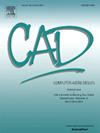Recent advancement in conformal cooling channels: A review on design, simulation and future trends
IF 3.1
3区 计算机科学
Q2 COMPUTER SCIENCE, SOFTWARE ENGINEERING
引用次数: 0
Abstract
The cooling phase of a moulded part plays a crucial role in the injection moulding (IM) process, accounting for 50 to 80 % of total cycle time, and significantly impacting the quality of moulded parts. During the last decade, the advancement of different additive manufacturing (AM) processes, especially metal 3D printing, has facilitated the production of mould parts, such as cores and cavities, with complex-shaped internal conformal cooling channels (CCCs). These innovative cooling systems exhibit significant potential to replace traditional straight-drilled cooling design, as they offer more efficient and uniform cooling performance by facilitating more effective heat transfer, considerably enhancing production quality and efficiency. Despite the growing attention being given to the design and manufacturing of CCC systems, there is still a lack of systematic and comprehensive classification, comparison and evaluation methodologies. This paper aims to review various types of conformal cooling channels, such as spiral, zigzag and nature-based designs, among others, and to provide an overview of advancements in design, process modeling and simulation of this new cooling technology. Previous studies have indicated that conventional straight-drilled cooling channels are likely to be replaced by CCCs, especially for complex and sensitive parts, due to their superior performance in reducing cycle times and enhancing product quality. The present study explores various challenges that arise when developing conformal cooling channels. These issues range from optimizing complex geometry to improving thermal performance through modelling. However, these challenges also present opportunities for innovation and advancement in mould design and manufacturing.

保形冷却通道的最新进展:设计、模拟及未来趋势综述
冷却阶段在注塑成型过程中起着至关重要的作用,占总周期时间的50%至80%,并对注塑件的质量产生重大影响。在过去的十年中,不同的增材制造(AM)工艺的进步,特别是金属3D打印,促进了模具零件的生产,如芯和腔,具有复杂形状的内部保形冷却通道(CCCs)。这些创新的冷却系统显示出取代传统直钻冷却设计的巨大潜力,因为它们通过促进更有效的传热来提供更高效和均匀的冷却性能,大大提高了生产质量和效率。尽管人们越来越重视CCC系统的设计和制造,但仍然缺乏系统和全面的分类、比较和评价方法。本文旨在回顾各种类型的保形冷却通道,如螺旋,之字形和基于自然的设计等,并概述了这种新型冷却技术的设计,过程建模和仿真的进展。先前的研究表明,由于CCCs在减少循环时间和提高产品质量方面的优越性能,传统的直钻冷却通道很可能被CCCs取代,特别是对于复杂和敏感的部件。本研究探讨了在开发保形冷却通道时出现的各种挑战。这些问题的范围从优化复杂的几何形状到通过建模提高热性能。然而,这些挑战也为模具设计和制造的创新和进步提供了机会。
本文章由计算机程序翻译,如有差异,请以英文原文为准。
求助全文
约1分钟内获得全文
求助全文
来源期刊

Computer-Aided Design
工程技术-计算机:软件工程
CiteScore
5.50
自引率
4.70%
发文量
117
审稿时长
4.2 months
期刊介绍:
Computer-Aided Design is a leading international journal that provides academia and industry with key papers on research and developments in the application of computers to design.
Computer-Aided Design invites papers reporting new research, as well as novel or particularly significant applications, within a wide range of topics, spanning all stages of design process from concept creation to manufacture and beyond.
 求助内容:
求助内容: 应助结果提醒方式:
应助结果提醒方式:


